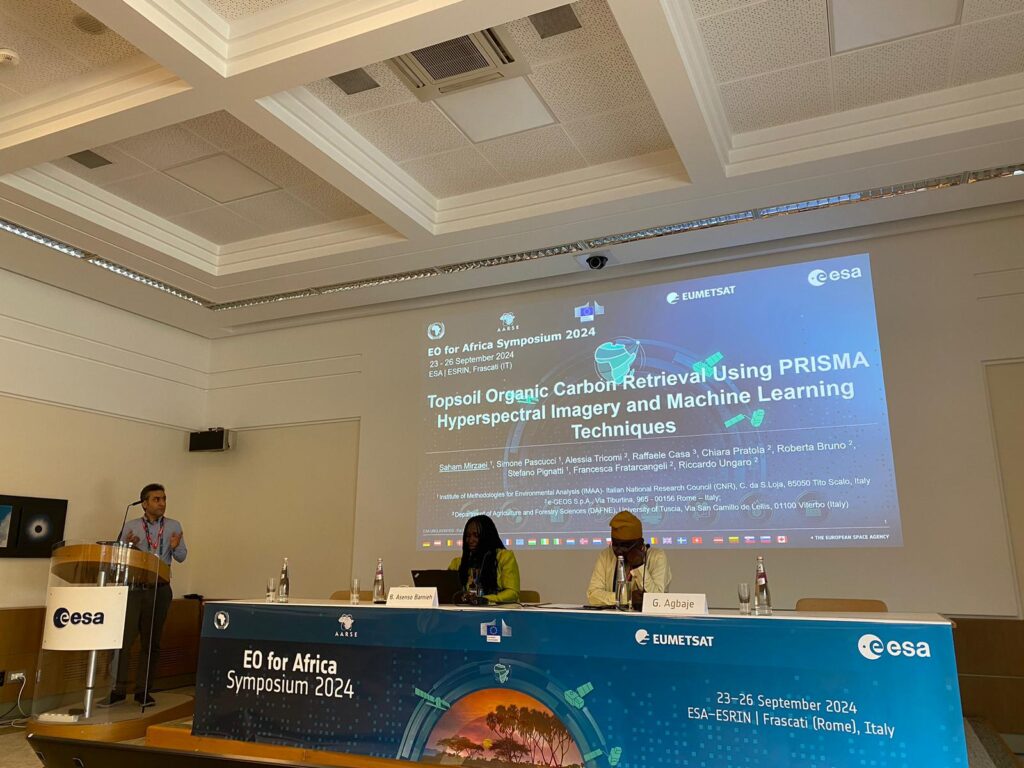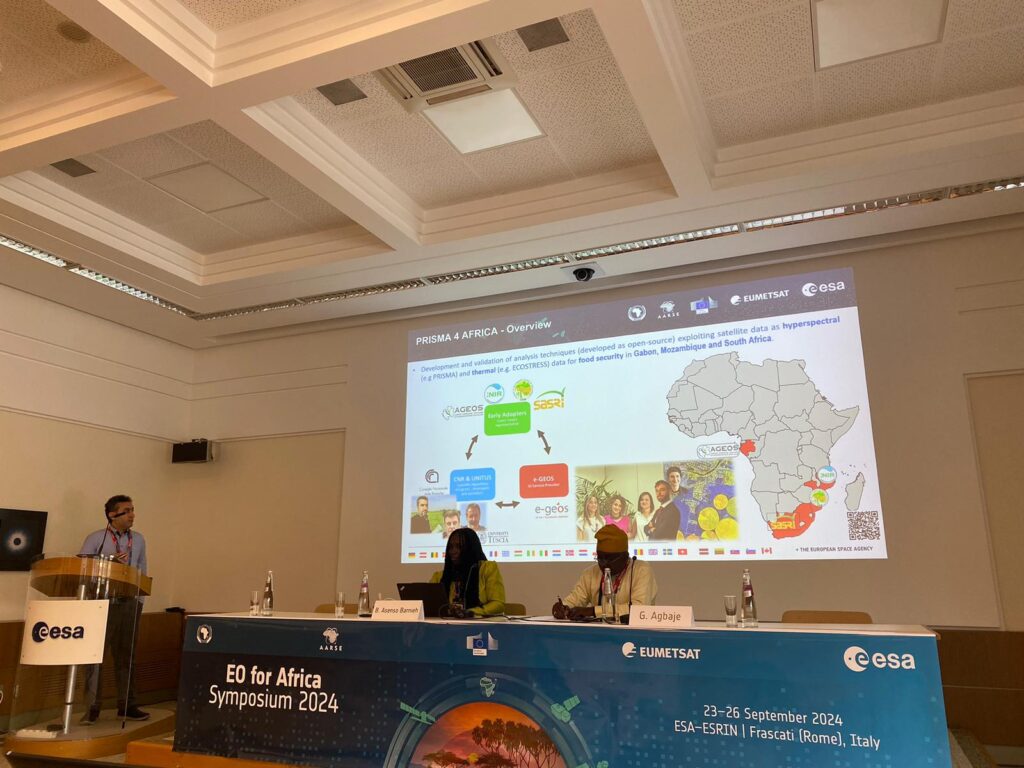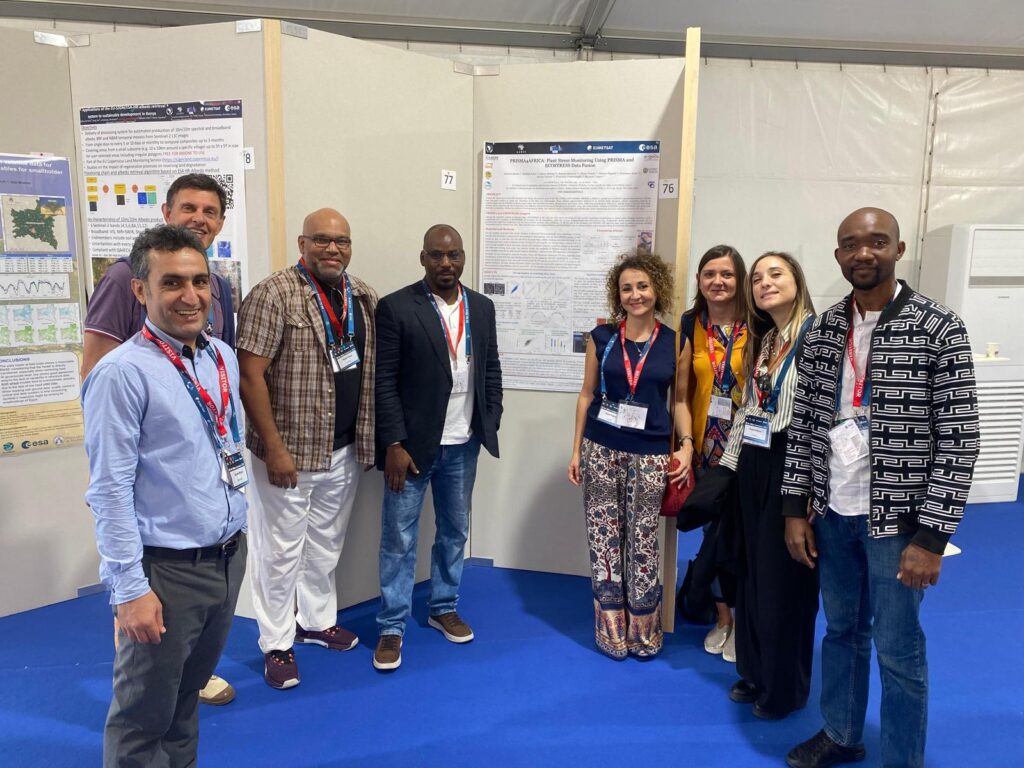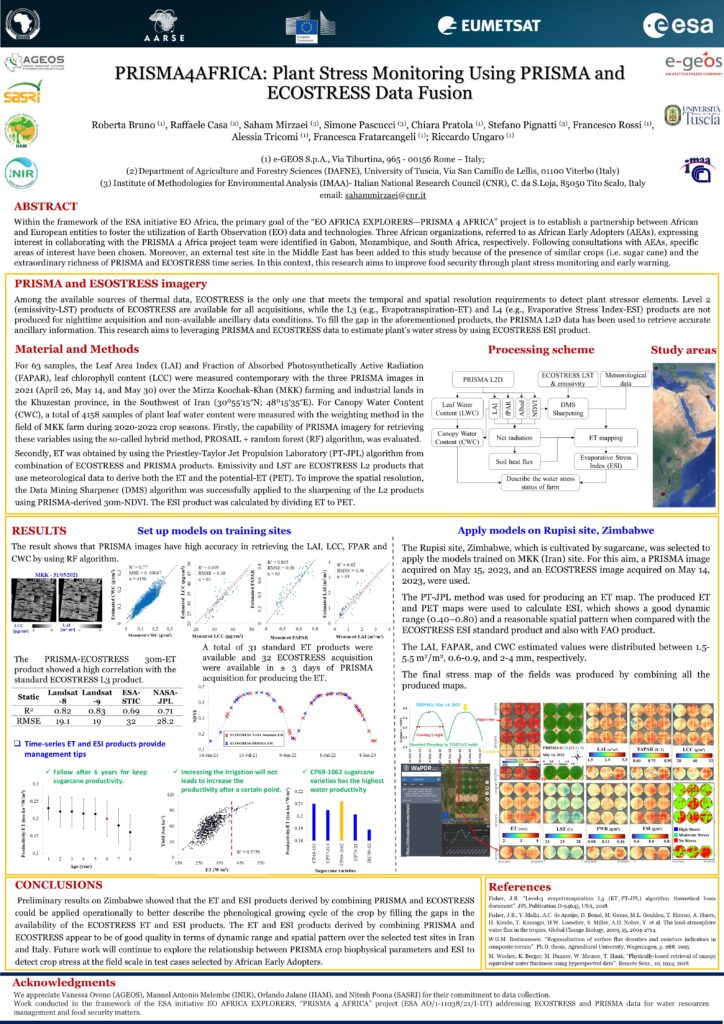Our work was presented at the EO for Africa Symposium 2024 (23-26 September, 2024 ESA-ESRIN) during both oral and poster sessions.
It was also a great opportunity to meet the team in person and strengthen our connections!

Oral presentation
Soil organic carbon (SOC) is a critical component of productive soils, and it is very important to allow for an efficient allocation of resources, optimal agricultural management, and the maintenance of fertile soils for best crop growth. The fast and accurate monitoring of SOC is among the most important activities to be included in the strategies to mitigate global warming because soils contain about 75% of the total carbon pool in land-based ecosystems. The proper estimation of SOC using satellite data is a challenging topic for the scientific community. Hyperspectral data acquired by new-generation spaceborne imagers like PRISMA (ASI, Italy) and EnMAP (German Mission) offers new opportunities to accurately map and quantify soil properties. Current SOC estimation from remote sensing is mainly targeted at the local scale, e.g., by using local databases to calibrate machine learning (ML) retrieval models. In this study, to avoid local parametrization of the retrieval algorithms, a wide number of PRISMA images (i.e., 32 clear sky images acquired during 2019–2024), encompassing a wide/regional topsoil variability and acquired over the southern African countries, were used. Samples of the free Open Soil Spectral Library (OSSL) dataset (https://soilspectroscopy.org/) have been used for CAL/VAL. The average of Sentinel-2 NDVI (up to 0.15) for ±12 days of each cloud-free PRISMA image present in the archive has been calculated in Google Earth Engine (GEE) and used as the primary criteria for PRISMA image selection. Among the primarily gathered dataset, a total of 104 samples were labeled as bare soils in the applied PRISMA images by using masks embedded in the EnMAP-Box tool (https://www.enmap.org/). The minimum, maximum, and standard deviation of these samples were 0.12%, 1.03%, 5.83%, and 1.23, respectively. The Level 2D PRISMA images were co-registered by the AROSICS algorithm using the Sentinel-2 image acquired at the closest date with PRISMA acquisitions to assure the co-registration (of about 0.5 pixels of RMS). Low signal-to-noise ratio (up to 100) and atmospheric water absorption bands were excluded, and a total of 173 spectral bands were used. Subsequently, smoothing of the spectra using a Savitzky-Golay filter with a third-order polynomial and a filter length of 7 was carried out. A k-fold (k = 10) was used for cross-validation. The primary results show that the first derivative of PRISMA absorbance spectra pre-treatments coupled with the Partial Least Squares Regression (PLSR) algorithm provides acceptable accuracy for SOC estimation (R2 = 0.68, RMSE = 0.684%). The capability of different ML retrieval algorithms, as well as different parametrizations of the MLs and different spectral pre-treatments, will be evaluated to find the best settings for SOC mapping. Increasing the number of PRISMA images in the archive over time will provide the opportunity to improve the accuracy of SOC estimation by covering more diverse soil samples in this region, including a wider range of SOC. The ongoing work, like the temporal transferability of spectral features and applying the button-up approach, is devoted to the up-scaling of this methodology to the African agricultural fields within the Gabon, Mozambique, and South Africa regions, selected within the context of the ongoing PRISMA4AFRICA project funded by the ESA.
Authors: Mirzaei, Saham (1); Pascucci, Simone (1); Tricomi, Alessia (2); Casa, Raffaele (3); Pratola, Chiara (2); Bruno, Roberta (2); Pignatti, Stefano (1); Fratarcangeli, Francesca (2); Ungaro, Riccardo (2)
Organisations: 1: Institute of Methodologies for Environmental Analysis (IMAA)- Italian National Research Council (CNR), C. da S.Loja, 85050 Tito Scalo, Italy; 2: e-GEOS S.p.A., Via Tiburtina, 965 – 00156 Rome – Italy; 3: Department of Agriculture and Forestry Sciences (DAFNE), University of Tuscia, Via San Camillo de Lellis, 01100 Viterbo, Italy
Download our presentation here: https://eo-4-africa-symposium-2024.esa.int/iframe-agenda/files/306_Mirzaei.pdf


Our poster
PRISMA4AFRICA: Plant Stress Monitoring Using PRISMA and ECOSTRESS Data Fusion
Within the framework of the ESA initiative EO Africa, the primary goal of the “EO AFRICA EXPLORERS—PRISMA 4 AFRICA” project is to establish a partnership between African and European entities to foster the utilization of Earth Observation (EO) data and technologies. Three African organizations, referred to as African Early Adopters (AEAs), expressing interest in collaborating with the PRISMA 4 Africa project team were identified in Gabon, Mozambique, and South Africa, respectively. Following consultations with AEAs, specific areas of interest have been chosen. In this context, this research aims to improve food security through plant stress monitoring and early warning. Among the available sources of thermal data, ECOSTRESS is the only one that meets the temporal and spatial resolution requirements to detect plant stressor elements. Level 2 (emissivity-LST) products of ECOSTRESS are available for all acquisitions, while the L3 (e.g., Evapotranspiration-ET) and L4 (e.g., Evaporative Stress Index-ESI) products are not produced for nighttime acquisition and non-available ancillary data conditions. To fill the gap in the aforementioned products, the PRISMA L2D data has been used to retrieve accurate ancillary information, e.g., Leaf Area Index (LAI) and albedo. The result shows that PRISMA images have high accuracy in retrieving the LAI (R2 = 0.824, RMSE = 0.35 m2/m2) and canopy water content (R2 = 0.837, RMSE = 0.019) by using a hybrid method, a combination of machine learning and PROSAIL. To improve the spatial resolution, the ECOSTRESS emissivity and LST products were sharpened using the Data Mining Sharpener (DMS) algorithm and PRISMA-derived 30m-NDVI. The PRISMA and ECOSTRESS images have been used to produce the potential and actual 30m-ET products of the Xinavane site, Mozambique, by the PT-JPL algorithm. The PRISMA-ECOSTRESS 30m-ET product showed a high correlation with ESA-STIC (R2 = 0.69, RMSE = 32 W/m2), Landsat 8/9-SSEBop products (R2 = 0.83, RMSE = 19 W/m2) and the standard ECOSTRESS L3 product (R2 = 0.81; RMSE = 0.36 mm). Finally, the 30m-ESI index was calculated from the potential and actual 30m-ET products. Preliminary results on Xinavane showed that the ET and ESI products derived by combining PRISMA and ECOSTRESS could be applied operationally to better describe the phenological growing cycle of the crop by filling the gaps in the availability of the ECOSTRESS ET and ESI products. The ongoing work is devoted to applying and optimizing this methodology in the other test areas of the PRISMA4AFRICA project.
Authors: Mirzaei, Saham (1); Pascucci, Simone (1); Tricomi, Alessia (2); Casa, Raffaele (3); Pratola, Chiara (2); Bruno, Roberta (2); Pignatti, Stefano (1); Fratarcangeli, Francesca (2); Ungaro, Riccardo (2); Rossi, Francesco (4)
Organisations: 1: Institute of Methodologies for Environmental Analysis (IMAA)- Italian National Research Council (CNR), C. da S.Loja, 85050 Tito Scalo, Italy; 2: e-GEOS S.p.A., Via Tiburtina, 965 – 00156 Rome – Italy; 3: Department of Agriculture and Forestry Sciences (DAFNE), University of Tuscia, Via San Camillo de Lellis, 01100 Viterbo, Italy; 4: Università di Roma La Sapienza, Scuola di Ingegneria Aerospaziale, Via Salaria 851, 00138 Roma


